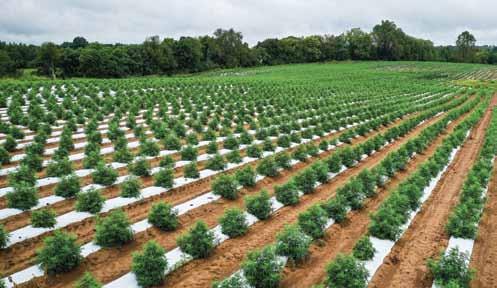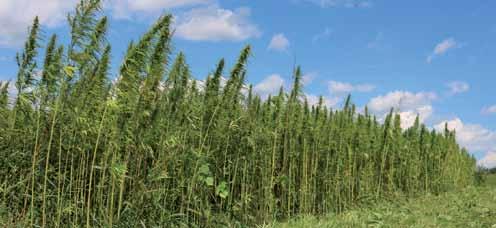
11 minute read
green living
Not All Hemp is Created Equal C BD American Shaman of PA continues to establish itself as an industry leader by introducing strains of cannabigerol (CBG) hemp flower, including Jack Frost and John Snow. CBG, the non-psychoactive “mother cannabinoid”, is one of more than 100 cannabinoids found in the cannabis plant.
It typically converts into cannabidiol (CBD) and tetrahydrocannabinol (THC) as the hemp plant grows, but some strains of industrial hemp, including Jack Frost, are bred specifically to produce high levels of CBG in order to take advantage of its beneficial effects. CBD and CBG bind to receptors in the body. CBD has been more extensively researched, while CBG is the “next big thing” in hemp products. Neither compound is psychoactive, meaning while they may have beneficial health-supporting properties, they won't give a “high” feeling. CBG is good for supporting a wide range of health systems, including mood, energy, sleep patterns, and muscle and joint function.
Advertisement
For CBD American Shaman of PA locations, see ads, pages 39 and 52.

Like us!
Natural Awakenings Lancaster/Berks
HEMP GETS HOT Meet the Hardest Working Plant on the Planet

by Julie Peterson

Acrop that was illegal in U.S. soil for more than half a century is now reaching for the sun. Industrial hemp, the low- or no-THC cousin to marijuana, has created high hopes among farmers, agricultural researchers, manufacturers and consumers. By 2019, America had become the world’s third-largest producer, behind Canada and China, where it’s been cultivated for 8,500 years.
“It’s the fastest-growing ag industry that we’ve ever seen,” says Tara Valentine, hemp specialist at the Rodale Institute, in Kutztown, Pennsylvania. Since hemp’s inclusion in the 2018 Farm Bill, Rodale’s hemp web page hits have grown 10-fold. Better Products All parts of the hemp plant are useful in multiple ways, and hemp has applications in textiles, construction, bioremediation, technology, nutrition and health, including cannabidiol (CBD). The seeds are rich in protein, essential fatty acids and vitamins. They can be eaten, ground into flour or pressed for oil that is used for cooking or in body care products. The stems undergo decortication to separate the long outer fibers (bast) from the short inner fibers (hurd). Hemp hurd makes extremely durable hempcrete for construction, absorbent and dust-free animal bedding or pellets for heating stoves. An exponential rise in the use of hemp is expected because it can replace products made from paper, wood, plastic, cotton and fossil fuels.
“Hemp fiber is going to dominate the market once we get to the full manufacturing potential,” says Erica Stark, executive director of the National Hemp Association, in Washington, D.C.
The first introductions consumers can expect include hemp paper products, such as plates and toilet paper, and biodegradable hemp bioplastics like cutlery and cups. Construction materials and other products are expected to quickly follow. Environmentally Friendly The Institute of Papermaking and Printing, at the Technical University of Lodz, Poland, did a 2015 study comparing making paper from wood to making it from hemp. Among the findings: hemp takes four months to grow, while trees need 20 to 80 years. An acre of hemp can produce Right now, it’s the Wild West of agriculture. ~Dustin Enge
four or more times as much paper as an acre of trees. Hemp paper doesn’t need toxic bleaching and can be recycled twice as many times. Other studies concur.
Paper without deforestation would be a major benefit, but it’s a minor job on hemp’s profound résumé. “Hemp needs to be a part of every climate change conversation, not only because it sequesters huge amounts of carbon during cultivation, but also because construction products made out of hemp will continue to sequester carbon for up to 100 years,” says Stark. Hemp could also help save the depleted soil on U.S. farmland that has been destroyed by tilling and synthetic fertilizers. “We have to rebuild the soil by putting carbon back in and increasing organic matter,” says Valentine. Hemp does this with a massive root biomass that breaks up compacted soils, improves water infiltration and reduces runoff and erosion.
Fast-growing hemp naturally suppresses weeds, needs no pesticides and isn’t picky about soil, water or latitude. By comparison, cotton is water-intensive and uses 25 percent of the world’s pesticides. soon. Manufacturers are anxious to start incorporating hemp,” says Stark.
The lack of buyers isn’t deterring farmers. Neither are warnings that current harvesting equipment can spark disaster when hemp fiber wraps around rotating parts, heats up and combusts.
Dustin Enge, a third-generation farmer in Prairie du Sac, Wisconsin, started Honey Creek Hemp in 2017. He planted six acres of hemp. “I think it’s a long-term viable commodity for farmers. Right now, it’s the Wild West of agriculture. Everyone

Income for Farmers Used in crop rotation, hemp’s soil-enhancing qualities can increase profits on subsequent crops. While cover crops don’t usually have return value, hemp provides additional revenue streams. But the revenue isn’t quite there yet, because the supply chain isn’t complete. Seed supply, farm equipment, education, processing facilities and manufacturers are all links that are developing simultaneously. “Fiber processing facilities will be available is trying different things,” says Enge, who modified a harvester for hemp. “I spent about two hours harvesting and 20 hours torching the fiber off my equipment.” Even so, he will plant more acres when he knows it will sell.
Behold the sprouting of the hemp industry as an ancient plant takes root in the modern world.
Julie Peterson writes from rural Wisconsin and can be reached at JuliePeterson2222@ gmail.com.

Pennsylvania Returns to a Strong Foundational Crop The Reemergence of Local Hemp Production

by Gisele Rinaldi Siebold
Fields of hemp once stretched across the landscape of Pennsylvania for more than 260 years and created a steady source of income for many farmers and their families. The strong fibers from the hemp plant’s core and bark proved to be versatile and were used to make clothing, sails, rope, cloth, paper and more. Penn State Extension Educator Jeffrey S. Graybill draws our attention to the fact, “The Declaration of Independence was printed on hemp paper. The sails of ships, like the USS Constitution, and the covers for the Conestoga wagons were all made from hemp fiber.”
According to Les Stark, hemp historian, founding member of the Pennsylvania Hemp Industry Council and author of Hempstone Heritage, historical records

indicate the operation of more than 100 water-powered, hemp-processing mills in Lancaster County alone, with hundreds more located throughout the state. Stark also confirms that Hempfield Township, Lancaster County, was formed in 1729, named for the “vast quantities of hemp raised there.” Hemp seed oil mills were also in operation to process hemp seed into oil that was used to make inks, paints, varnishes and lamp oil.
Hemp is a strain of the Cannabis sativa plant that has a very low tetrahydrocannabinol (THC) content. Unfortunately, it became linked with the high-THC content variety specifically cultivated to produce marijuana for its narcotic components. This caused the growth and production of hemp
Want the benefits from cannabis without the high?
The Green Bee offers Lancaster’s largest selection of quality hemp CBD products:
u Locally-grown Lancaster County Hemp CBD u Top-quality products sourced across the USA
The Green Bee u 30 E McGovern Ave Lancaster u 717-330-5079 u thegreenbee.net Located directly across from the Lancaster Train Station Come visit us: Mon-Fri 10am-7pm & Sat 10am-6pm
to be banned in the U.S. in the late 1930s, with the exception of hemp fiber production during World War II. Decades later, research found THC to be the cannabinoid component that, in very high doses, causes intoxicating, psychoactive effects in humans, but hemp production had already been halted in the U.S.
The 2014 Farm Bill made hemp production legal again in programs for research purposes, while scientific and educational findings have recently brought hemp production to the forefront for its many industrial, farming, health and wellness benefits. The 2018 Farm Bill allows hemp to be grown commercially outside of a research pilot program. According to the Pennsylvania Department of Agriculture, caps on the number of hemp permits and amount of acreage per permit were removed in 2019, and the department issued 324 growing permits for farms that planted just over 4,000 acres of hemp. In 2020, the department is committed to fostering the conditions for Pennsylvanians to grow a profitable, sustainable, in-demand hemp product.
The team at the Rodale Institute, in Kutztown, is exploring hemp’s potential to suppress weeds, add diversity to crop rotations and boost farmers’ bottom lines by conducting an industrial variety trial and a weed competition trial. They think hemp enhances soil health as a cover crop by shading out weeds—reducing the need for synthetic herbicides—and adding diversity to crop rotations. So far, their research has shown that industrial hemp is a resilient plant that grows very quickly and performs just as well if not better than other cover crops. Their research will continue through the end of the year.
The Rodale Institute team believes that hemp is also versatile in the marketplace, with thousands of uses for its seed, oil and fiber. Hemp can be used to make textiles, building material, livestock bedding, paper products, bioplastics and more. It is stronger and more durable than cotton, yet requires less space and less water to grow. Hemp’s desirability means that successfully cultivating it can also improve the livelihoods of organic farmers.
Local farmer, designer and consultant Steve Groff created Hemp Innovators, a community and network of farmers and
professionals navigating the hemp industry together. Groff and John Stoltzfus, Jr., two of six partners in Keystone Agri-Science, concur with improving the livelihoods of farmers. They are part of a group of businessmen and farmers collectively supporting approximately 50 farmers that have transitioned to farming hemp for cannabidiol (CBD) production.
Keystone Agri-Science provides a viable crop option for farmers to assist in debt reduction and creates new jobs and opportunities for education, support, group meetings, problem-solving and brainstorming. They purchase most of the hemp flowers grown by the collective (although the farmers are free to sell elsewhere), and use them for CBD. They developed Lancaster County Brand and Hanf (German for hemp), two CBD companies for wholesale and retail business offering CBD salves, tinctures, body lotion, massage oil and other products.
CBD, the most abundant cannabinoid found in hemp, has therapeutic applications. Heather Kreider, CEO of Lancasterbased Hempfield Botanicals, says “CBD is an example of a phytocannabinoid, a plantproduced cannabinoid. The human body also produces endocannabinoids on its own. They help support the endocannabinoid system, recognized for its role in regulating immune system functions, inflammatory response, blood sugar, body temperature, hormones, stress response, sleep, mood and emotions, metabolism and more.
“When our endocannabinoid system is deficient or compromised in some way, we can experience a variety of unpleasant physical and emotional symptoms that might prevent us from doing the things we love to do and enjoying life to its fullest,” explains Kreider. “CBD from hemp may help support our endocannabinoid system by imitating endocannabinoids to keep cannabinoid receptors working optimally.” Hemp hearts (shelled hemp seeds) contain all nine essential amino acids, and are a healthy, plant-based source of protein, fiber and omega-3 fatty acids. Their nutritional benefits support heart and brain health, as well as the immune system, and help to reduce inflammation. The nutritional content and omega-3 fatty acids in hemp oil make it another healthy choice when creating recipes and boosting meal preparation variety. It may also beneficially contribute to skin care and massage therapy regimens.
Recognized around the world for its strength and versatility, hemp is a beneficial crop to regard as we look to enhance our healthy, sustainable lifestyles and wellness journeys with plant-based components.
For more information: Hempfield Botanicals, 717-874-8480, HempfieldBotanicals.com Hemp Innovators, HempInnovators.com John Stoltzfus, Jr., 717-226-0751, JStoltzfus@HanfExtracts.com Penn State Extension, Extension.psu.edu Pennsylvania Hemp Industry Council, pahic.org Pennsylvania Department of Agriculture, Agriculture.pa.gov Rodale Institute, 610-683-1400, RodaleInstitute.org Steve Groff, 717-575-6778, SteveGroff.com
HEMPISHEALTH.COM

Follow us:
TAKE ON THE BETTER YOU CHALLENGE
@CBDofPA

A healthier, happier YOU is created from more than a gym membership or diet plan. Don’t take on a new year’s challenge by yourself, let CBD help you reach your goals by giving you the physical and mental relief needed to persevere. You will be rewarded for sticking to your goals with an extra 5% off of your purchase each month for six months, starting with 10% off in month 1 − that’s 35% off in month 6! Get started today and let CBD American Shaman of PA be there for YOU.
CARLISLE, PA 404 East ∙ High St 717-254-6643 HARRISBURG, PA 2250 Linglestown Rd (Next to GIANT Food Store) 717-510-6686 LANCASTER, PA 2355 Oregon Pike Suite 105 (Shoppes at Landis Valley) 717-874-5146 NOW OPEN !
MECHANICSBURG, PA 5224 Simpson ∙ Ferry Rd 717-620-8532










